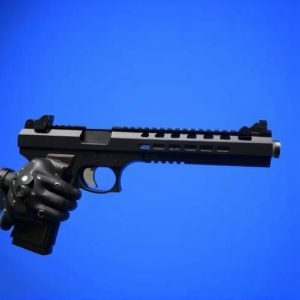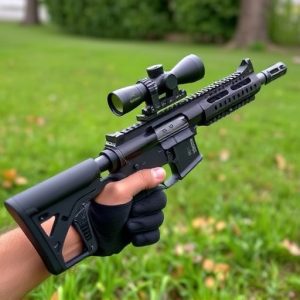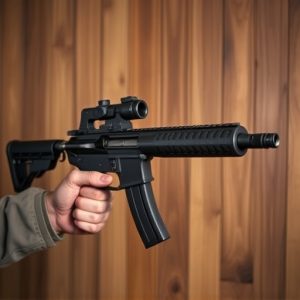Non-Lethal Home Defense Weapons: Safety, Legalities, and Choices
Non-lethal home defense weapons, including pepper spray, stun guns, noise devices, and impact weapon…….
Non-lethal home defense weapons, including pepper spray, stun guns, noise devices, and impact weapons, offer a responsible and effective way to protect families and property without causing permanent harm. These tools, along with smart home devices, provide diverse options for security while adhering to ethical and legal standards. Understanding the legal landscape, specific application areas, and safety protocols is crucial for informed decision-making and proper usage of these weapons.
In today’s world, ensuring your family’s safety at home is paramount. Non-lethal home defense weapons offer a viable alternative to traditional firearms, providing a layer of protection without ending lives. This comprehensive guide explores various types of non-deadly force tools, delving into their legal aspects and offering crucial training tips for effective use. Discover how to choose the right device tailored to your needs, ensuring peace of mind while adhering to relevant regulations.
Understanding Non-Lethal Home Defense Weapons
Non-lethal home defense weapons are designed to incapacitate or deter intruders without causing permanent harm, focusing on protecting families and property while adhering to ethical and legal standards. These tools offer a middle ground between conventional firearms and non-intervention, providing homeowners with enhanced security and peace of mind.
Understanding the concept behind these weapons is crucial for responsible ownership. Non-lethal options range from pepper spray and stun guns to noise devices and impact weapons, each employing specific methods to disrupt an assailant’s abilities without causing life-threatening injuries. By educating themselves about various types and their applications, homeowners can make informed decisions, ensuring they’re prepared to defend their spaces effectively while respecting the well-being of others.
Types of Non-Deadly Force Tools
Non-lethal home defense weapons are designed to incapacitate or deter an intruder without causing permanent harm, making them a popular choice for homeowners seeking to protect their families and properties. These tools range from non-lethal firearms and stun guns to more unconventional options like pepper spray, tasers, and even smart home devices capable of emitting high-pitched sounds or releasing flashing lights. Each type offers unique features tailored to different situations and preferences.
Stun guns, for instance, use an electric current to temporarily paralyze an attacker, while pepper spray can cause temporary blindness and difficulty breathing. Tasers, which fire small probes connected to a powerful electrical pulse generator, are highly effective in neutralizing threats without the risk of permanent injury. Non-lethal firearms, such as shotguns loaded with non-lethal rounds or airsoft guns, simulate the look and feel of real firearms while delivering less potent force. Smart home devices, leveraging technology like motion sensors and integrated security systems, offer remote monitoring and response capabilities, enhancing overall safety without requiring physical intervention.
Legal Considerations and Regulations
When considering non-lethal home defense weapons, it’s crucial to understand the legal landscape surrounding their use. Different regions have varying regulations on what constitutes a non-lethal weapon and under what circumstances they can be employed legally. Owning and carrying such weapons may require permits or certifications, and there are often restrictions on who can possess them—for instance, only for personal protection or as part of a specific profession like law enforcement.
These legal considerations extend to the type of force allowed in self-defense situations. Some non-lethal weapons, such as pepper spray or stun guns, have specific rules regarding their use. For example, they might be prohibited from being aimed at the head or face or used against certain vulnerable populations. Always research and comply with local laws and regulations to ensure legal and ethical usage of non-lethal home defense weapons.
Choosing the Right Device for Your Safety
When considering non-lethal home defense weapons, it’s crucial to match your choice with your specific needs and environment. Factors like personal comfort, household members, and potential intruders all play a role in this decision. For instance, spray devices are effective for creating temporary incapacitation, ideal for situations where you need time to escape without causing permanent harm. Stun guns, on the other hand, offer a hands-off approach, delivering a powerful electric shock that can subdue an attacker momentarily.
Assess your living space and typical scenarios of concern. If you live in a high-rise apartment, a long-range non-lethal option like a tactical flashlight or noise device might be suitable for deterring intruders at a distance. For rural homes with larger properties, a personal alarm system or even a guard dog could provide added security. The key is to choose a device that enhances your safety without escalating conflicts, ensuring you’re prepared for unexpected events while adhering to legal and ethical guidelines regarding non-lethal home defense weapons.
Training and Safety Tips for Effective Use
When it comes to training with non-lethal home defense weapons, proper education and practice are key. Start by understanding your specific weapon’s mechanics, including its range, stoppages, and any unique features. Attend workshops or courses conducted by certified instructors who can teach you effective deployment techniques and safety protocols. Practice regularly in a controlled environment to build muscle memory and refine your aim.
Safety should always be the top priority. Always wear protective gear, especially eye and face protection, during training sessions. Ensure your weapon is properly maintained and stored securely when not in use. Keep it out of reach of children and unauthorized individuals. Regularly review safety guidelines specific to your chosen non-lethal home defense weapon, as proper handling can prevent accidents and ensure its effectiveness in emergency situations.


